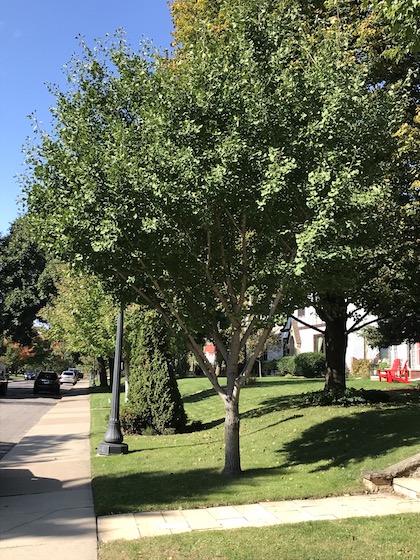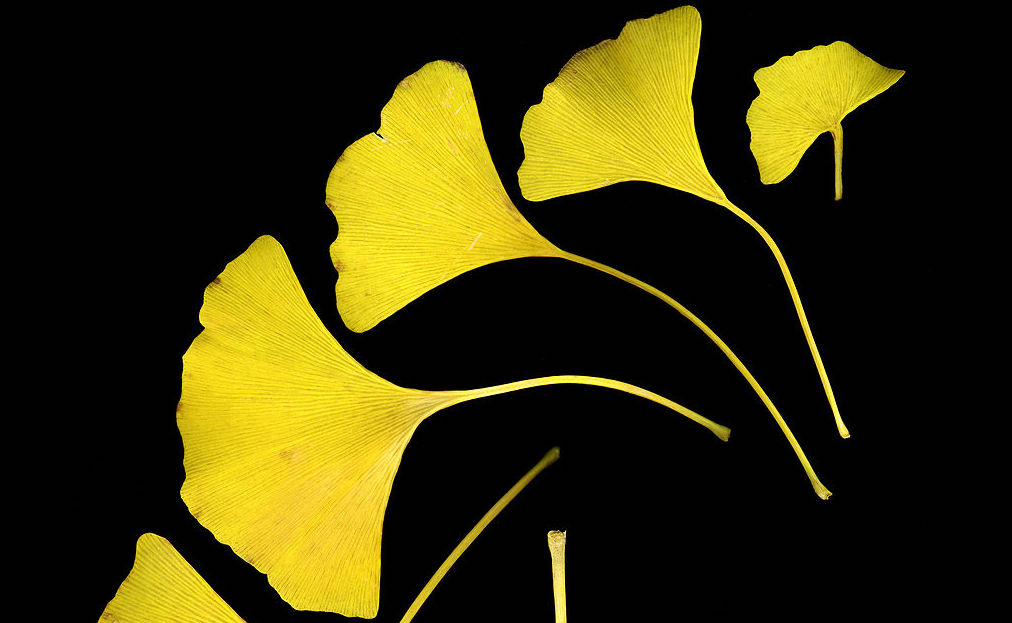Plant Profile: Ginkgo Tree
There’s been a lot of conversation recently about the most resilient trees to plant in the North to endure climate change. One that is always on the list is the Ginkgo tree (Ginkgo biloba ), which is a tough urban tree that can handle salt, has the right height and shape to be a boulevard tree and offers stunning fall color and an unusual leaf shape. They also have basically no pests or diseases. The only concern about ginkgos is that they are nonnative trees, and consequently offer very little for our native pollinators.
A Living Fossil

Ginkgos have been called living fossils because the genus has been around more than 200 million years. It is the only living species in the Ginkgophyta family. As a street tree, this fossil rocks. It grows slowly to a mature height of 50 to 80 feet with lovely spreading branches. The leaves are fan-shaped and a soft green color through spring and summer. In fall, they turn a bright yellow-orange, and often fall all at once, creating a carpet on the grass. Interestingly, they do not turn color every year, which has to do with the weather and how quickly summer turns to near winter.
Most ginkgos you will find in nurseries and garden centers are male trees. The female ginkgo tree produces a seed that has a soft covering that rots as the summer and fall progress. The odor from the rotting seed flesh is pretty strong and not pleasant. It isn’t fool-proof when nurseries identify male vs. female trees so sometimes people will get a female when they think they bought a male.
Cultivars
The species ginkgo grows very well in the North, but plant breeders have come up with a number of cultivars of ginkgo with special characteristics. For instance, Princeton Sentry™ is a narrow ginkgo, growing 40 feet tall and only 15 feet wide. Autumn Gold is hardy to USDA Zone 3 and has a broader appearance and symmetrical branching, as well as a golden fall color. Magyar ginkgo is a faster growing cultivar with a uniform shape.
For a tough street tree, ginkgo is definitely worth considering.


Bad choice if you get a female. Horrible, rotten odors and as the season turns to winter, the pods end up rotting on the sidewalk and become dangerously slippery. St. Paul chose ginkgo trees to replace long lost elms and more expensive maples. They came back years later and ripped them out of the ground.
That is a problem! The city of St. Paul is recommending them again because of their disease resistance and ability to withstand climate change. https://mynortherngarden.com/2019/04/22/best-climate-hardy-trees-for-the-north/
Being non native is enough for me to say “not in my backyard”. Amur Maple is creeping into our woods much as Buckthorn. Same with European Maples…displacing native flora etc.
there must be acres of these growing in nursery fields though Amur Maple, beautiful as it is, will soon disappear from garden centers. We don’t need more trees from Asia.
Thank you for the recommendation but I’d not be happy if I got a female version as the possibility of getting the messy fruit and odor are a deal breaker.
Do you have any other suggestions?
I would like to start some ginkgo trees from seed, but am in Zone 3 in Montana. Do you know who might direct me to the northernmost or coldest climate female ginkgo trees growing in Minnesota?
Hi Don, I just came across this article and your question. I am also in zone 3 – Winnipeg Manitoba. Ginkgo is pretty well an unknown tree here but I have a few my largest is only 6 feet tall if that. In my experience Ginkgo seedlings (if too young/small) will just suffer winter kill and have a hard time establishing in zone 3, if they survive. If you start with a 3 or 4 foot tree, however, they are a bit hardier as they age. I bought a few 4 foot high trees from a nursery in Ontario that deals with fruit and nut trees. They were shipped barefoot but have established fine. Also, My experiment tells me that un-named seedling ginkgo seem hardier than the named cultivars plus cheaper to.
To Don Jackson- I am in Minneapolis- I have a “Ginkgo Cluster”- basically several trees that grew from seed tossed into a pot by my father probably around 1980- he had harvested the seed from the monster Ginkgo on the Carl Sandburg Estate in North Carolina, “wintered ” them in the fridge , & threw them in a pot. (in NC) & then moved them to Southern California- still in the pot. When he died in 1986 I brought the pot to MN, finally planted it in my yard, & it has absolutely THRIVED. True, I am Zone 4, but these trees are tough as shit.
In the late 1940’s & early -50’s, Papa did research with ginkgo, looking at sapling chromosomes , trying to find an easy, cost effective way to sex the saplings before boulevard-planting- Ginkgo has no insect vectors – has been around since the Jurassic, as I recall- so- don’t worry too much about getting “Northern” seed. my ‘southern’ seedlings are 20 ft tall now
I purchased a home with a male ginkgo that is raising the foundation of an addition that was built some time after 1970. The tree looks much older and I was told it is maybe 80 years old. I estimate that it’s 65 feet tall and would post a picture if I could. I feel like a murderer cutting this big beautiful tree down, but everyone tells me it must go.
I understand the dilemma, Mike. We removed an 80 year old fir when we moved into our home — but, it was threatening the foundation. It had to go. Yours may need to, too. You might want to consult with an arborist, if you don’t want to remove it.
Hi, Mike,
I’d keep the tree and figure out how to deal with the addition structure.
I’m an arborist. And I love ginkgos. I’m biased towards trees. And the Twin Cities grows some beautiful Ginkgos!
Washington’s state park system includes the Ginkgo Petrified Forest near Vantage, Washington, where you can see petrified wood fossils of ginkgo trees. The petrified trees are 15.5 millions years old and the tree has died out in North America since then. So ginkgos may be considered non-native trees now, but they would have been native trees at one time. Just a very, very long time ago.
Any info on the size that ‘Autumn Gold’ Ginkgo grows in Northern climes? I’ve seen measurements all over the map – from 6 meters wide (20 ft) to 10 meters (33 feet). The heights also are given as anything from 40 – 50 feet and up. If you could also mention the age of your Ginkgo, that would be very helpful as well. Thanks in advance!
Hi Martine, you may want to contact an arborist in your zone for the most accurate answer.
I was hoping to find a male ginkgo tree. To go with a bench that will serve as memorial for classmates that have passed. The site area: La Crosse, WI. Have been working with parks n rec. Dept. They say it’s hard to find.
Hi Ron, you could reach out to our Discount Partner nurseries to see what’s available – they may be able to order something for you or point you in the right direction if they don’t have a tree in stock. Here’s a full list with addresses and phone numbers: https://northerngardener.org/membership/discount-partners/